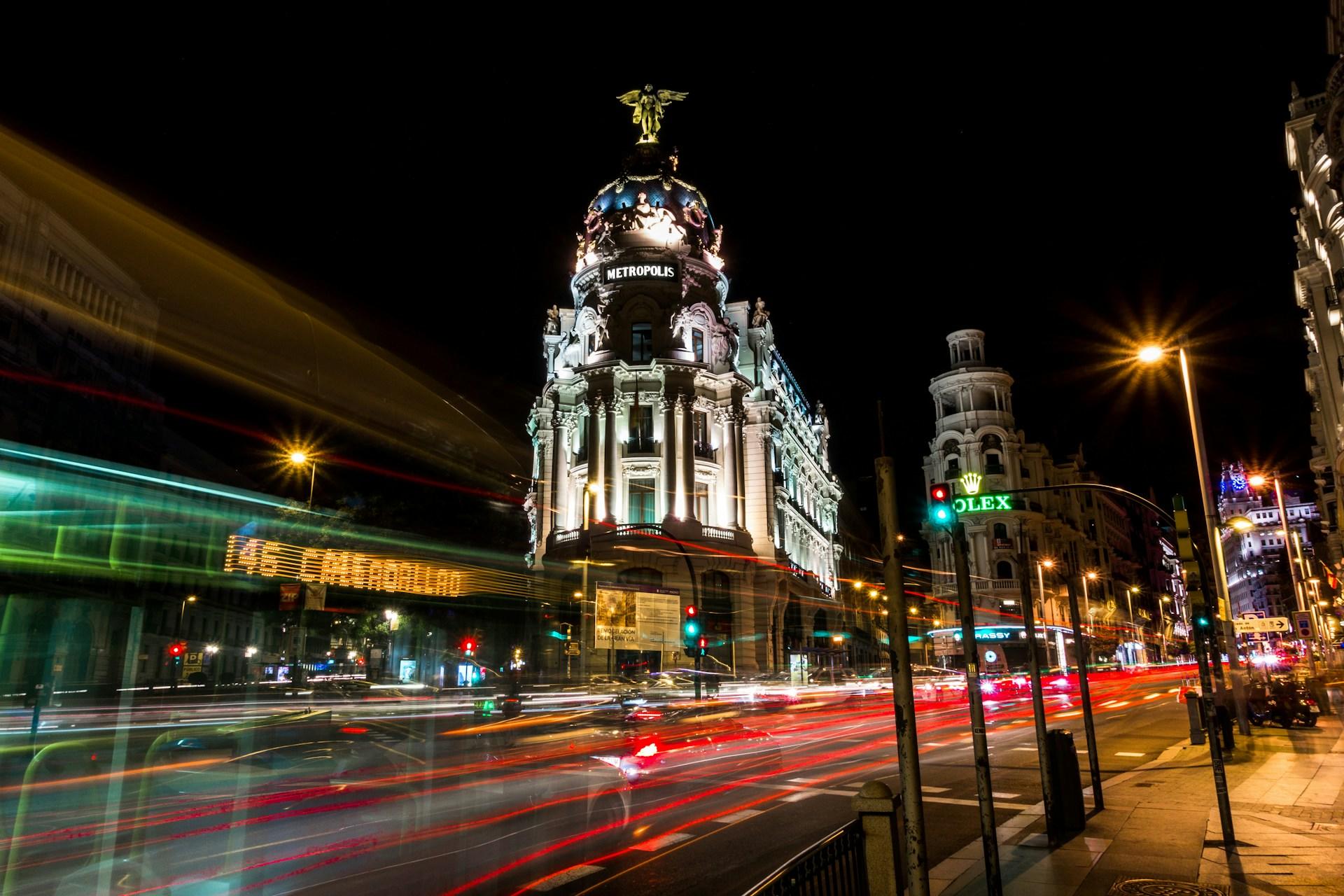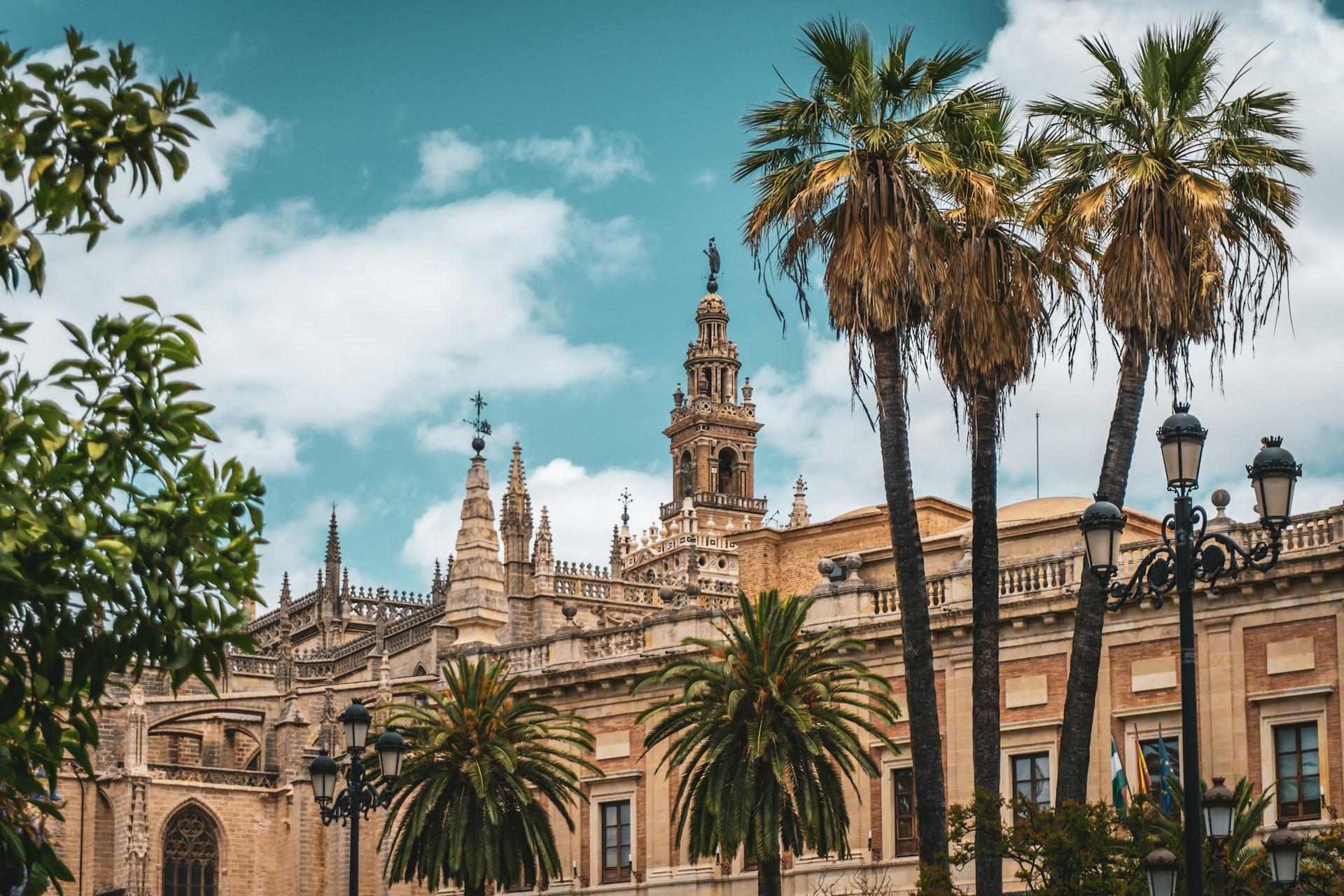To explore Spain is to immerse yourself in a rich mix of history, culture, and breathtaking architecture. From the majesty of the Alhambra in Granada to the avant-garde modernity of the City of Arts and Sciences in Valencia, each destination offers a unique experience. Are you ready to tour this fascinating country and explore the best travel guide to visit Spain? ¡Empecemos ahora mismo!

1. Enjoy a sunset with the Alhambra in the background 📸
The Alhambra is a beautiful complex of buildings and gardens in Granada, Spain. This place is known for its lush tree landscapes and abundant water flowing through its streams. The Alhambra is a visual spectacle with a rich history as the Muslim West's major political and aristocratic center.
The Alhambra was the residence of the Nasrid sultans and is one of Europe's finest representations of Islamic architecture. Its rectangular courtyards, fountains, and Nasrid buildings were abodes for the kings and their servants. The oldest building is the Alcazaba, a fortress that offers the best views and sunsets of Granada.
How to get to Alhambra
- From the city center of Granada: The bus lines that take you from the center to the Alhambra are the C30 or C32. They depart every 8-12 minutes from the Isabel Católica Square (Columbus monument). Get off at the bus stop called "Alhambra - Generalife 2", the last stop for the bus C30.
- On foot: The best option is to walk up from the Plaza Nueva through the beautiful Puerta de las Granadas (Pomegranates Gate).
- By car: Parking is available near the Alhambra. However, it may be limited during the high season.
Costs: To visit the monumental complex, purchase a general ticket to the Alhambra (14 € or approx. 20.72 CAD). This type of ticket gives access to every part of the Alhambra.
Pros and Cons:
- Pros: The Alhambra is a UNESCO World Heritage Site, which guarantees its cultural and architectural value. It also offers spectacular views of Granada and the surrounding mountains.
- Cons: Like all tourist attractions, the Alhambra can be very crowded during the high season. Some parts of the complex may require additional entrance fees, and its steep terrain can challenge people with reduced mobility. Also, here, you must practice the common Spanish words for traveling since locals may not speak English.

2. Discover Gaudí's the Sagrada Familia ⛪️
The Sagrada Familia is one of the most emblematic works of Antoni Gaudí and one of the most important symbols of Barcelona that you cannot miss. The most fascinating fact about the Sagrada Familia's history is that it is still an unfinished church 140 years after its construction. This monument is one of Spain's most visited tourist attractions and has been declared a World Heritage Site by UNESCO. The Sagrada Familia combines neo-Gothic influences with Gaudí's organic and naturalistic vision, making it a unique reference in world architecture.
How to get to the Sagrada Familia
- By train from the airport: Take the R2 Nord train to Sants station, then change to metro line L5 (blue) to the Sagrada Familia.
- From the center of Barcelona: By metro, you can take lines L2 (purple) and L5 (blue), which stop at the Sagrada Familia station. You can take several lines by bus, such as 19, 33, 34, 43, 44, 50, and 51.
- On foot: The Sagrada Familia can be reached approximately 20-30 minutes from the Eixample district.
Costs: General admission costs approximately 26 euros (approximately 38.48 CAD), and access to the towers costs approximately 36 euros (approximately 53.28 CAD). Free admission is available for children under 11 and people with disabilities.
Pros and cons:
- Pros: The Sagrada Familia is a world-renowned architectural and cultural gem that offers breathtaking views of Barcelona.
- Cons: The place could be very crowded, especially in high season. Also, entrance fees can be expensive, especially access to the towers.

3. Visiting Madrid: A Capital Full of Life 🎊
Madrid is the vibrant capital of Spain and one of the most important cities in the world due to its combination of history, culture, and modernity. Madrid is a must-see destination for any traveler due to its tourist attractions, nightlife, gastronomy, and the ideal place to practice your Spanish most common phrases. The city is home to some of the most important art collections in the world, such as the Prado Museum. The city is famous for its architecture, from the Royal Palace to its Plaza Mayor.
How to get to Madrid
- From Madrid-Barajas Airport (Adolfo Suárez): Metro line 8 connects the airport with the city center. Also, line C-1 goes from Terminal 4 of the airport to the center of Madrid.
- From other Spanish cities: Madrid is connected to other major Spanish cities by high-speed train (AVE), with departures from Barcelona, Seville, and Valencia.
Costs
- Accommodation: Hotel prices vary from 50 euros (74 CAD) per night in budget hotels to over 300 euros (444 CAD), depending on the type of tourism you are interested in.
- Attraction tickets: Prices tend to vary; for example, entrance to the Prado Museum costs approximately 15 euros (22.20 CAD), while entrance to the Royal Palace costs around 13 euros (19.24 CAD).
Pros and Cons
- Pros: Madrid is home to world-renowned museums, theaters, and cultural events throughout the year. It also offers a wide variety of dining options. In addition, Madrid has bars, nightclubs, and live shows that run late into the night.
- Cons: In peak seasons, Madrid can be very crowded, and summers can be extremely hot, with temperatures often exceeding 35°C. Like any large city, traffic can be heavy, especially during rush hour.


4. Traveling back in Time at Cathedral of Seville 🕌
The Cathedral of Santa Maria de la Sede in Seville is the largest Gothic cathedral in the world and one of the most impressive in Europe. With a height of 104 meters, the Giralda, a bell tower, is one of the most recognized icons of the city, offering unparalleled panoramic views of Seville. In addition, the Cathedral of Seville is a UNESCO World Heritage Site and is one of the masterpieces of Gothic, Islamic, and Renaissance architecture.
How to get to Seville
- From Seville Airport (San Pablo): You can take the EA bus (Airport Special) to Plaza de Armas bus station and walk for about 15 minutes.
- From the center of Seville: If you want to walk, the cathedral is in the heart of the old town of Seville. Or, you can take the T1 line and get off at the Plaza Nueva stop. Also, several bus lines have stops nearby, such as lines C5, 5, and 40.
Cost: General admission costs approximately 12 euros (17.76 CAD). Discounts are available for students and seniors over 65, and admission is free for children under 14 accompanied by an adult.
Pros and Cons
- Pros: The Cathedral of Santa Maria de la Sede in Seville is one of the most important cathedrals in the world, with a rich history.
- The cons: The place could get crowded, especially during high season and religious festivities. Climbing the Giralda can be challenging for people with reduced mobility.

5. Lose yourself in Valencia's City 🎨
The City of Arts and Sciences is an impressive architectural and cultural complex designed by Santiago Calatrava and Félix Candela. It has become one of the city's most emblematic symbols and a world reference in modern architecture. The City of Arts and Sciences is known for its futuristic architecture and spectacular structures. It is one of the most visited destinations in Spain, attracting millions of tourists each year.
How to get there
- From Valencia Airport (Manises): Take line 3 or 5 to Xàtiva station and then bus 35 to the City of Arts and Sciences.
- From Valencia City Center: Several bus lines arrive at the complex, including lines 13, 14, 15, 19, 35, 95 and 99. Also, if you like bicycles, Valencia has an excellent bicycle rental system. Alternatively, you can walk there in approximately 30-40 minutes.
Cost: Combined packages are offered. For example, the Science Museum + Hemisfèric costs approximately 14-15 euros (20.72 CAD to 22.20 CAD), and the Oceanogràfic + Science Museum + Hemisfèric costs approximately 38-40 euros (56.24 CAD to 59.20 CAD).
Pros and Cons
- Pros: The City of Arts and Sciences offers everything from science and nature to performing arts. It is ideal for families and people interested in learning about science and technology.
- Cons: Entry to several attractions can add up quickly, especially if visiting as a family, and it can also be very crowded, especially during vacations and weekends.

Learn Spanish phrases with Superprof! 🥇
Learning the Spanish language with Superprof is the best way to master the language and get ready for your trip to any Spanish-speaking country. Thanks to personalized private tutoring tailored to your specific needs and goals, becoming fluent in the language is easier than you think.
Superprof offers access to a vast network of expert tutors across Canada who will guide you in learning the language and improving your Spanish skills. Master Spanish with the best private tutoring. Welcome to Superprof!
Wrap up!
Spain has diverse and captivating locations, each with its rich history and stunning beauty that draws in countless tourists annually. Whether you're strolling through the peaceful Alhambra gardens, getting a tour of the sights or marveling at the cutting-edge architecture of the City of Arts and Sciences, every moment visiting these famous attractions of Spain will give you invaluable memories. Prepare to uncover various cultural treasures and breathtaking architectural marvels that will stay with you long after your visit.















